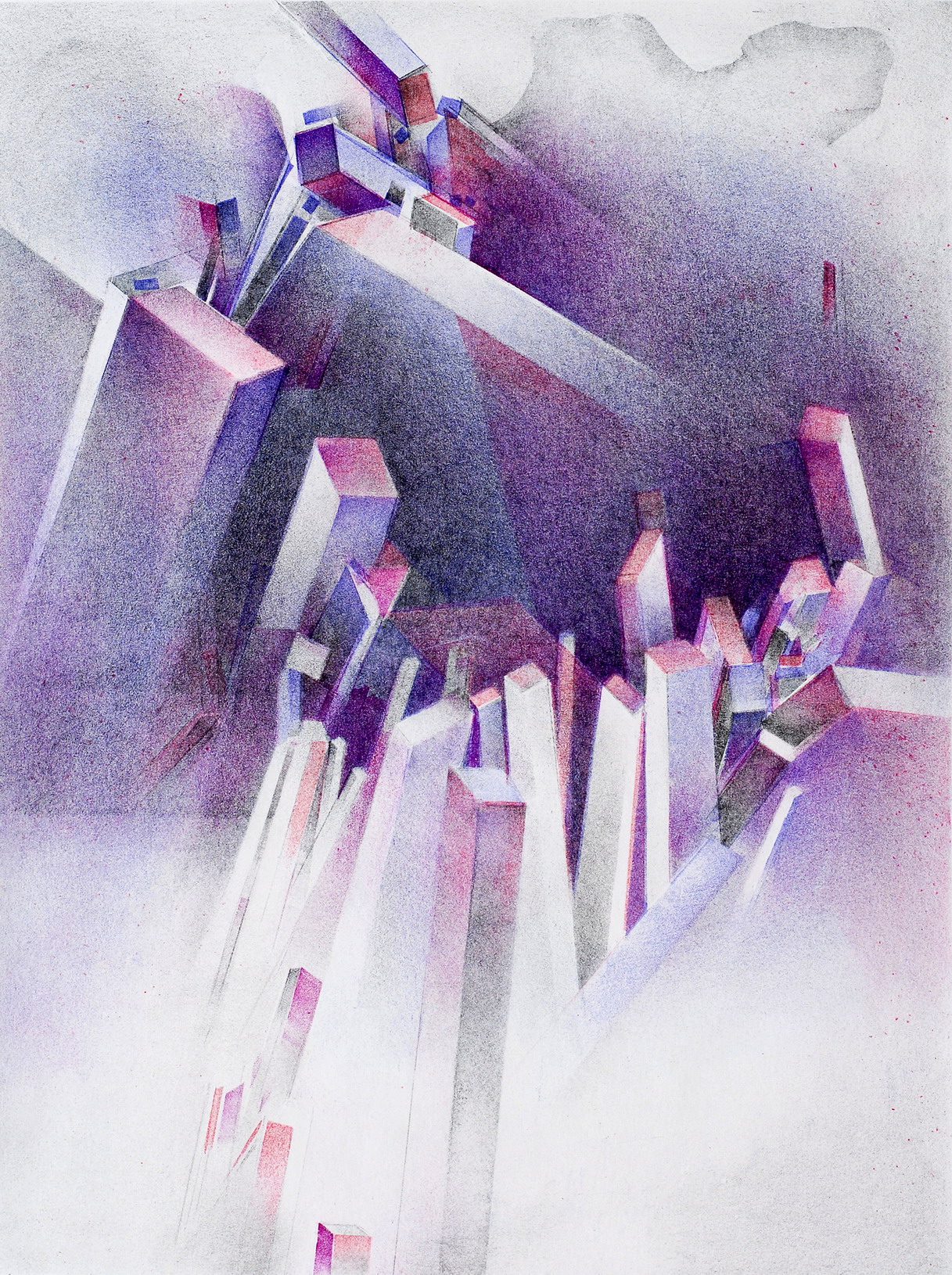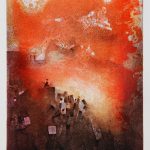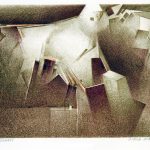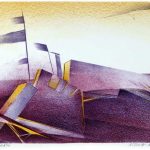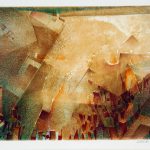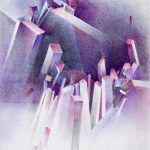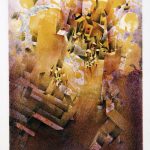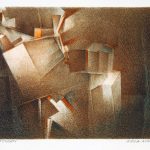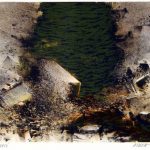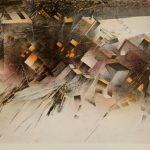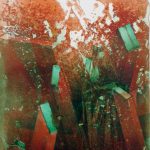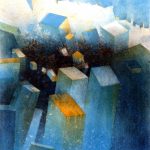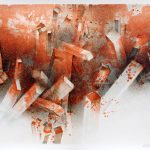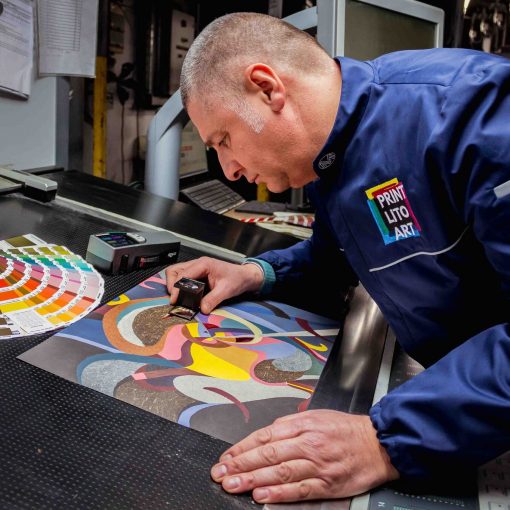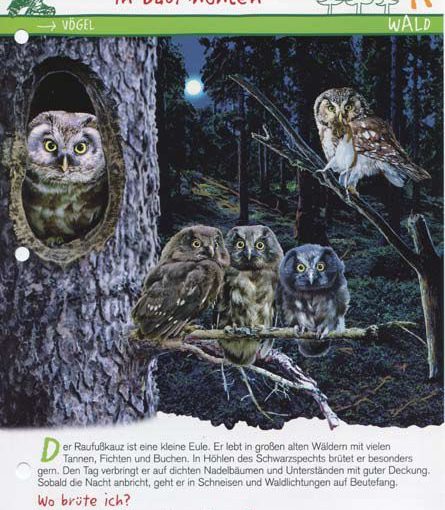Le grafiche del professore Atilla Atar trasmettono tutto il piacere che la raffinatezza ed il fascino di un opera d”arte possono dare ad un essere umano.
ON THE LITHOGRAPHIES OF ATİLLA ATAR
In his most recent work, Atilla Atar employs images with allusions to the deterioration of natural life and the environment, a matter of which we hear increasingly more and one which in the near future may become our fore most problem. Our attention is drawn to the problematic on which this work focusses, that is, the heedlessness of humanity towards the milieu in which it lives, and the damage recklessly inflicted thereon. With this thematic outlook as a ground, the artist characterizes fragmented forms which appear scattered to the surface, powerful masses that have lost their balance, and voids among them calling to mind the profundity of the depths, all in an atmosphere whose impression is one of desertification and drought in a seeming desire to show us the desolation to which we will be led by the disrupting of equilibrium in nature. It is now generally agreed that a range of factors, from unplanned urbanization to industialization and its wastes, have turned the balance of nature on its head. In particular, the century from which we have just emerged, although it had certain constructive aspects, with its relationship to natural and environmental factors is remembered as a century which, directly or indirectly, left irrevensible, irreparable and ineradicable scars. The worst part is that, as things stand today, the ruthless exploitation of nature has become a habit to which we are inured, whether it be conscious or unconscious. Perhaps this should be viewed as an extension of a psychological disturbance, a perverse quest for happiness in the satisfaction of our own selfish nature. In his latest pictures Atar brings to his work these problems, problems which our life puts off but which are an indispensable part of it; and using them seems to give clues to a lost future. We are confronted by a world that is barbarically harrmed, deserted and above all ebandoned by man. A cold world remote from the human. Mechanical and monotonous. Architectural elements, their equilibriurn gone; cities which have known disaster…A world where life and destruction are closely entwined, where visions of the future are lost while uncertainty and absence of humankind reign…Unlike the crowded cities of our day, which have become temples, human beings have withdrawn from these regions,and they remind one of evacuated, deserted habitations…Just what can cities without people express? In a lifeless, soulless, desert world. A spirit seems to rule that annihilates humankind and renders it invisible.An evil spirit. Perhaps it is not a question of a ghost city, but still, this place is undesired and unwanted. Crumbled, ruine, unbalanced and skewed. . . Focussed on the priority of atmosphere, this gloomy picture naturally transforms each element into a Metaphor of fragmentation, chaos and, in the face of these, our profound sorrow. Made up of multiple fragments, the compositional structure is masterfully imbued with relations to result in a dynamic, tense atmosphere. The disorder following an explosion, the damage that results, the powerful masses scattered about, the bits and pieces flung to the surface, all naturally produce a certain energy and tead to a characteristic and original style. Such being the case, images reminiscent of the power and massiveness of architectural structures, but which at the same time wander out of balance in space, impart the feeling of a sceptical, hopeless gaze to become the message of the work.Despite all that has been determined and expressed above, it would be difficult to assess Atar’s lithographies in the category of a figurative approach. The same trouble crops up when we try to label them as abstract. Thus one might say that they manage to achieve a character somewhere between figurative and abstract. Or rather it might be more correct to assert that their character involves the intimate mingling of the abstract and the objective. And this takes them beyond an approach nourished by sheer visual impact to ensure that, as a problematic, they impart the image of a destructive devastating culture, one to which we have frequently been witness in recent times. Evolving from the figurative towards the abstract in a linear path of development, Atar’s art at the point which it has reached reiterates, albeit differently the emphasis of his earliest work; life which due to artificial intervention has lost its essential qualities. In his first works, although like many artists he used the forms of nature and saw their images as conveying his ideas, nevertheless he interpreted these in the context of their form-meaning relations to turn them into a system of signs. Each time, a style dominated by a meticulous, refined approach achieved balance by masterfully avoiding exaggeration. And throughout the process of transformation, what is noticeable and insistently preserved is that , whether they are figurative or abstract. the forms always are grasped in line with a deep perception of space, as opposing extremes dissolve within each other. In this way,even the most decisive and contrary forms blend in these compositions thanks to a spirit of conciliation. Here surfaces, planes and transitions acquire importance. Despite the superimposed layers, the forms are sparely and clearly distinct. Insistently preserved as it achieves the quality of belonging is the textural effect arising from the method and materials used, and this transforms the entire surface into an organic whole consisting of tiny points. This in turn invokes a rhythmic motility to spread to the surface with a resultant poetic atmosphere. The fact that this is more concentrated in some parts of the picture surface transforms it into a luminous veil for the hard architectural masses and broken, scattered fragments, while on the other hand it works against their hardness through a dissolving in interplanar transition to unify the obiect with space. But in each case this light, covering objects like a blanket of fog, embraces the rigid formal composition, itself nourished by a geometric spirit, to surrender the entire structure to the law of a filtered tuminosity. Considering at alll these characteristic features, one might say that Atar ‘s art has a style parallel to the lyrical abstract approach. In conclusion, a disturbing artificiality and the culture which it creates are transformed in these pictures, through tense, stimulating and at the same time rich imagery that inhabits the surface, into a spare, striking, poetic style. The determined emphasis placed on all this goes beyond the dullness of life to subtly impart the longing felt for vanishing human values. I suppose the basic paradox at this point is that more and more we forget the truth about ourselves and, playing with our own nature, show so well how unnecessarilly skilled we are turning it upside down. Hayri Esmer

